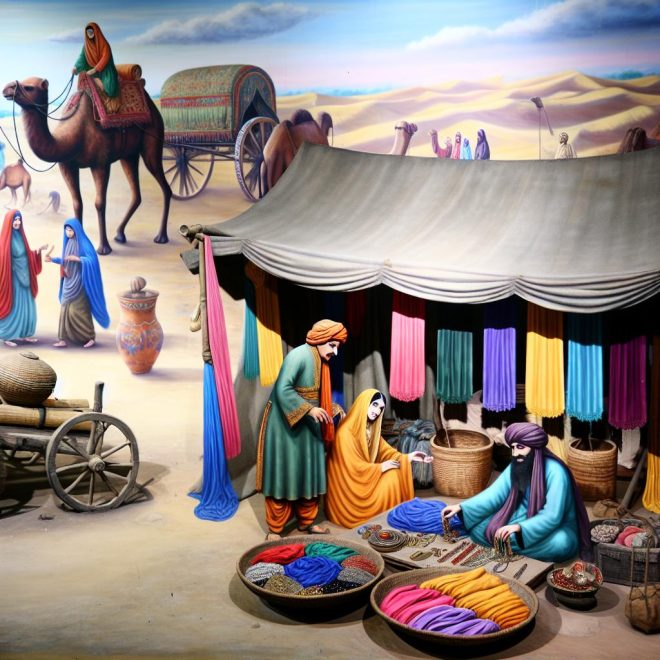The Silk Road and Economic Exchange
The Silk Road was a vast and intricate web of trade routes that bridged the great expanse between the East and West. This ancient network was instrumental not just for the exchange of goods, but also for the rich intermingling of cultures, ideas, and technologies. The economic landscapes of numerous civilizations found transformation through their interactions along the Silk Road. Central to this thriving trade network were the Persian and Indian merchants, whose pivotal roles helped in cultivating a flourishing economy.
Persian Merchants and Their Influence
Persian merchants emerged as quintessential figures in the Silk Road trade as pivotal intermediaries bridging East and West. The geographical advantage of Persia, located in present-day Iran, uniquely positioned it as a strategic connector among various trading hubs. Renowned for their negotiation skills and ability to nurture enduring trade relationships, Persian traders became indispensable in the Silk Road’s complex economic exchanges.
Key Commodities and Trade Goods
Among the myriad goods traded by Persian merchants, silk stood out as a highly coveted commodity. Symbolizing luxury and status across cultures, silk threads wove far-reaching economic influence. Alongside silk, they traded spices and precious metals, bolstering Persia’s reputation across distant lands. Detailed insights into the Persian trade impact can be accessed through resources available on accredited academic platforms.
Trade Networks and Infrastructure
The trade practices of the Persians were supported by a meticulously developed network of inns and rest houses that dotted the challenging terrain of the Silk Road. These facilities functioned as critical nodes where merchants and their caravans could find safety and rest. By promoting trade efficiency, they not only safeguarded the precious goods but also enhanced the overall commerce infrastructure across these routes.
Indian Merchants and Their Economic Contributions
Indian merchants were integral to the success of the Silk Road, contributing significantly to the economic and cultural exchanges that unfolded along these ancient pathways. Their connections linked the rich reservoir of the Indian subcontinent’s natural and cultural resources to other parts of Asia and beyond.
Commodities Traded by Indian Merchants
Indian exports were revered for their diversity and quality. Merchants engaged in the trade of textiles, spices, and gemstones. Indian textiles, especially the vibrant cotton and silk, commanded attention for their exquisite quality and intricate beauty, while spices like pepper and cardamom were globally sought after for their flavor and preservative properties.
Cultural Exchange and the Spread of Ideas
Beyond tangible commodities, Indian merchants played a quintessential role in the cultural and philosophical exchanges along the Silk Road. A notable illustration is the spread of Buddhism, which found new adherents along these routes due to the frequent interactions facilitated by trade. The trade routes, therefore, became conduits for spiritual and philosophical ideas, as well as economic goods. Further exploration can be accessed through trusted scholarly journals.
The Interconnectedness of Persian and Indian Traders
Despite their distinct roles, Persian and Indian merchants existed in an ecosystem marked by significant interconnectedness. Their interaction along the Silk Road was central to the seamless flow of goods and information between distant continents, linking regions from China to the Mediterranean basin.
Collaborative Trade Practices
The cooperative trade practices exhibited by Persian and Indian merchants provided strategic solutions to the complex challenges posed by vast distances and varying political landscapes. Collaborative efforts involved a shared understanding of trade routes and pooling of resources, resulting in more streamlined commerce and broader mutual benefit. This collaboration strengthened trade networks, demonstrating how collective strategies could facilitate expansive economic exchanges.
Conclusion
In summation, Persian and Indian merchants were instrumental to the operation and legacy of the Silk Road, each bringing distinct strengths that complemented the other’s contributions. Their influence spanned beyond mere monetary transactions, cultivating a dynamic tapestry of cultural and technological exchanges. The legacy they left is a compelling testament to the power of trade as a bridge for cultures and economies, a legacy that continues to inspire contemporary understanding of interconnected trade networks. Through their dedication, the Silk Road became an enduring symbol of economic and cultural interconnectedness.
